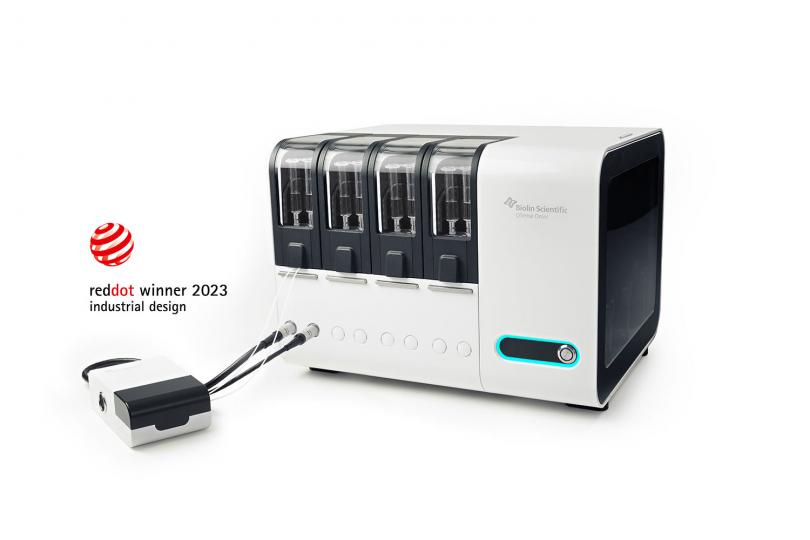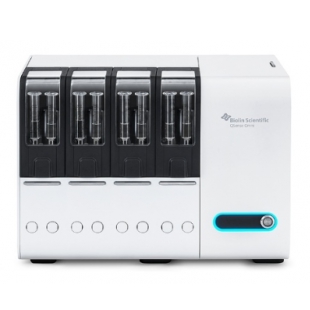-
产品文章
-
QSense耗散型石英晶体微天平在制药领域中的应用
发布:瑞典百欧林科技有限公司浏览次数:17QSense耗散型石英晶体微天平在制药领域中的应用

QSense 耗散型石英晶体微天平技术
耗散型石英晶体微天平(QCM-D)技术是一项表界面敏感且多功能的分析技术,主要用于研究薄膜、生物分子相互作用以及其他与表界面相关的过程。QCM-D技术能够提供关于分子在固体表面吸附、相互作用和稳定性的宝贵见解。
QCM-D技术可以实时监控石英晶体芯片的谐振频率随时间的变化。芯片的谐振频率取决于其质量,因此频率的变化可以揭示与芯片表面耦合的质量变化。同时,还可以实时监控系统的能量损失(耗散),从而量化芯片上涂层的粘弹性特性。这些频率和耗散的变化可用于分析分子与芯片表面的相互作用。
QCM-D技术是由瑞典百欧林科技有限公司和瑞典查尔姆斯理工大学的科学家们共同开创的,自1999年首台原型机问世以来,QSense耗散型石英晶体微天平产品系列不断扩大。如今,QSense已成为石英晶体微天平仪器的世界leader,广泛应用于制药、生物技术、能源、电子、材料、食品、环境、化学、矿物加工等领域。数千篇文献证明了QSense技术的可靠性。以下将主要探讨QSense耗散型石英晶体微天平技术在药物相互作用方面的应用。
(一)药物开发
QSense的纳克级别质量灵敏度为药物发现和开发提供了无限潜力。通过QSense进行的研究活动包括:
1. 各种实验条件下,实时精确监测小分子药物与蛋白质、细胞膜和RNA的相互作用。[1]
2. 蛋白质-蛋白质相互作用[2]
3. 小分子与RNA相互作用时,RNA的结构变化[3]
(二)药物递送
QSense已被证明是一种成本效益高、时间效率高的技术,特别适用于表征脂质纳米颗粒(LNP)及其药物递送特性方面。大量文献证明QSense可以用于:
1. 分析血清蛋白与脂质纳米颗粒(LNP)的结合亲和力[4]
2. 生物分子(如siRNA和mRNA)在LNP上的结合与释放[5]
3. 将LNP递送到目标器官[6]
4. 在无细胞环境中筛选血清蛋白与LNPs的结合亲和力[7]
5. 分析LNPs的表面修饰[8]
6. 脂质与生物活性分子(包括药物、DNA和siRNA)的相互作用[9]
7. ApoE结合后对脂质成分分布和整体LNP结构的影响[24]
8. 用于存储功能化LNP的纳米孔阵列[25]
9. 提高LNPs核酸载荷递送效率的LNP配方[26]
10. 使用cDNA将微泡固定到支持的脂质双层上[27]
11. 稳定化立方体的嵌段共聚物与生物模拟脂质膜的相互作用[28]
(三)药物-表面相互作用
QSense在表征药物配方与表面相互作用方面具有重要意义,涵盖了生产、纯化、储存和递送过程中的多个方面。特别是评估生物制药药品在整个生命周期中的表面吸附/解吸附过程以及吸附层的结构变化。
典型案例包括:
1. 药物与聚合物、玻璃、金属和金属氧化物、硅油等表面的相互作用[10],[11],[12],[13],[14],[15],[16]
2. 辅料在减少药物-蛋白质吸附到表面上的效果[17]
3. 配方条件(浓度、pH值、温度等)的影响; [18]
4. 界面和界面应力在生物制品开发中的影响[19]
药物-表面相互作用研究用QCM-D芯片列表
塑料包装
聚丙烯 (PP)
聚氯乙烯 (PVC)
聚对苯二甲酸乙二醇酯 (PET)
聚甲基丙烯酸甲酯 (PMMA)
聚乙烯 (PE)
低密度聚乙烯 (LDPE)
高密度聚乙烯 (HDPE)
线性低密度聚乙烯 (LLDPE)
玻璃容器
硼硅酸盐玻璃
苏打石灰玻璃
包装袋
环烯烃聚合物 (COP)
环烯烃共聚物 (COC)
过滤材料
聚偏二氟乙烯 (PVDF)
聚四氟乙烯 (PTFE)
聚碳酸酯 (PC)
聚醚砜 (PES)
聚对苯二甲酸乙二醇酯甘油改性 (PET-G)
预充填注射器
注射器 PDMS(硅油)
其他相关材料
聚苯乙烯
纤维素
不锈钢L605
SS2343(类似于美国标准316)
乙烯-醋酸乙烯共聚物 (EVA)
尼龙
聚氨酯
醋酸纤维素
聚丙烯腈 (PAN) *
*注:多达 200 种芯片,可根据用户要求定制芯片表面
(四)生物材料与人体组织的相互作用
植入体和生物材料在人体内的生物相容性是它们成功发挥作用的关键。QSense提供了在分子层面对植入体表面或生物材料与人体血液和组织相互作用的体外分析。
1. 各种眼部护理配方与黏蛋白/细胞膜表面的相互作用[20]。
(五)生物传感器开发
QSense也被广泛用于蛋白质生物传感器和即时检测传感器等类型传感器的开发中。
1. 蛋白质生物传感器[21],[22]
2. 即时检测传感器(Point-of-care sensors)[23]
QSense Omni 耗散型石英晶体微天平
QSense Omni 是由QCM-D技术的先驱者瑞典百欧林科技有限公司推动研发的新耗散性石英晶体微天平型号,是QCM-D新技术的集大成者。Omni比市面上任何一款QCM的灵敏度都要高,这使它能够量化和监测更小的分子、更快的过程,是研究生物过程非常理想的工具。QSense有超过100多种芯片表面材料和涂层可供选择,支持模拟真实生物环境和过程,以表征蛋白质吸附速率、薄膜形成、吸附层刚性、钙化、细胞附着等。

QSense Omni 耗散型石英晶体微天平
能够检测芯片表面微小至0.24 ng/cm²的变化
更快的流体交换(5倍于上代产品),提供更快和更清晰的样品输送
全系列自动化功能,minimize用户依赖性
更简化的工作流程和全新直观的软件界面,使更广泛的用户可以更加容易地使用QCM-D。
参考文献:
[1] Small-molecule-mediated control of the anti-tumour activity and off-tumour toxicity of a supramolecular bispecific T cell engager Nat. Biomed. Eng 2024, 8 (5), 513–528. https://doi.org/10.1038/s41551-023-01147-6.
[2] Genentech – Viscoelastic characterization of high concentration antibody formulations using quartz crystal microbalance with dissipation monitoring Journal of Pharmaceutical Sciences 2009, 98 (9), 3108–3116.
https://doi.org/10.1002/jps.21610.[3] Roche – Reconstitution and Functional Analysis of a Full-Length Hepatitis C Virus NS5B Polymerase on a Supported Lipid Bilayer ACS Cent. Sci. 2016, 2 (7), 456–466. https://doi.org/10.1021/acscentsci.6b00112.
[4] A Fast and Reliable Method Based on QCM-D Instrumentation for the Screening of Nanoparticle/Blood Interactions Biosensors 2023, 13 (6), 607. https://doi.org/10.3390/bios13060607.
[5] A QCM-D and SAXS Study of the Interaction of Functionalised Lyotropic Liquid Crystalline Lipid Nanoparticles with siRNA ChemBioChem 2017, 18 (10), 921–930. https://doi.org/10.1002/cbic.201600613.
[6] Helper lipid structure influences protein adsorption and delivery of lipid nanoparticles to spleen and liver Biomater. Sci. 2021, 9 (4), 1449–1463.
https://doi.org/10.1039/D0BM01609H.
[7] AstraZeneca – Screening of the binding affinity of serum proteins to lipid nanoparticles in a cell free environment Journal of Colloid and Interface Science 2022, 610, 766–774. https://doi.org/10.1016/j.jcis.2021.11.117.
[8] Insights into the mechanisms of interaction between inhalable lipid-polymer hybrid nanoparticles and pulmonary surfactant Journal of Colloid and Interface Science 2023, 633, 511–525.
https://doi.org/10.1016/j.jcis.2022.11.059.
[9] On the interactions between RNA and titratable lipid layers: implications for RNA delivery with lipid nanoparticles Nanoscale 2024, 16 (2), 777–794.
https://doi.org/10.1039/D3NR03308B.
[10] Genentech – Adsorption and Aggregation of Monoclonal Antibodies at Silicone Oil–Water Interfaces Mol. Pharmaceutics 2021, 18 (4), 1656–1665. https://doi.org/10.1021/acs.molpharmaceut.0c01113.
[11] Bristol-Myers Squibb – Mechanistic Understanding of Protein-Silicone Oil Interactions Pharm Res 2012, 29 (6), 1689–1697.
https://doi.org/10.1007/s11095-012-0696-6.
[12] Bristol-Myers Squibb – Adsorption of polypropylene oxide-polyethylene oxide type surfactants at surfaces of pharmaceutical relevant materials: effect of surface energetics and surfactant structures Pharmaceutical Development and Technology 2019, 24 (1), 70–79. https://doi.org/10.1080/10837450.2018.1425431.
[13] Bristol-Myers Squibb – Particle Characterization for a Protein Drug Product Stored in Pre-Filled Syringes Using Micro-Flow Imaging, Archimedes, and Quartz Crystal Microbalance with Dissipation AAPS J 2017, 19 (1), 110–116.
https://doi.org/10.1208/s12248-016-9983-1.
[14] Pfizer – Engineering a ceramic piston pump to minimize particle formation for a therapeutic immunoglobulin: A combined factorial and modeling approach. J Adv Manuf & Process 2023, 5 (1), e10142.
https://doi.org/10.1002/amp2.10142.
[15] Antibody adsorption and orientation on hydrophobic surfaces Langmuir 2012, 28 (3), 1765–1774.
https://doi.org/10.1021/la203095p.
[16] AstraZeneca – The Impact of the Metal Interface on the Stability and Quality of a Therapeutic Fusion Protein Mol. Pharmaceutics 2020, 17 (2), 569–578. https://doi.org/10.1021/acs.molpharmaceut.9b01000.
[17] Janssen Pharmaceuticals (Johnson and Johnson) – Quartz Crystal Microbalance as a Predictive Tool for Drug-Material of Construction Interactions in Intravenous Protein Drug Administration Journal of Pharmaceutical Sciences 2023, 112 (12), 3154–3163. https://doi.org/10.1016/j.xphs.2023.07.019.
[18] Eli Lilly – Surface Interactions of Monoclonal Antibodies Characterized by Quartz Crystal Microbalance with Dissipation: Impact of Hydrophobicity and Protein Self-Interactions Journal of Pharmaceutical Sciences 2012, 101 (2), 519–529.
https://doi.org/10.1002/jps.22771.
[19] Bristol-Myers Squibb – Overview of the Impact of Protein Interfacial Instability on the Development of Biologic Products In Protein Instability at Interfaces During Drug Product Development; Li, J., Krause, M. E., Tu, R., Eds.; AAPS Advances in the Pharmaceutical Sciences Series; 2021; Vol. 43, pp 1–8.
https://doi.org/10.1007/978-3-030-57177-1_1.
[20] Novartis Pharma – Understanding the adsorption and potential tear film stability properties of recombinant human lubricin and bovine submaxillary mucins in an in vitro tear film model Colloids and Surfaces B: Biointerfaces 2020, 195, 111257. https://doi.org/10.1016/j.colsurfb.2020.111257.
[21] Dual-mode and Label-free Detection of Exosomes from Plasma Using an Electrochemical Quartz Crystal Microbalance with Dissipation Monitoring Anal. Chem. 2022, 94 (5), 2465–2475. https://doi.org/10.1021/acs.analchem.1c04282.
[22] Amplified QCM-D biosensor for protein based on aptamer-functionalized gold nanoparticles Biosensors and Bioelectronics 2010, 26 (2), 575–579. https://doi.org/10.1016/j.bios.2010.07.034.
[23] Bioactivated PDMS microchannel evaluated as sensor for human CD4+ cells – The concept of a point-of-care method for HIV monitoring. Sensors and Actuators B: Chemical 2007, 123 (2), 847–855.
https://doi.org/10.1016/j.snb.2006.10.034.
[24] Apolipoprotein E Binding Drives Structural and Compositional Rearrangement of mRNA-Containing Lipid Nanoparticles. ACS Nano 2021, 15 (4), 6709–6722. https://doi.org/10.1021/acsnano.0c10064.
[25] Development of Nanopackaging for Storage and Transport of Loaded Lipid Nanoparticles. . Nano Lett. 2023, 23 (14), 6760–6767.
https://doi.org/10.1021/acs.nanolett.3c01271.
[26] Review of structural design guiding the development of lipid nanoparticles for nucleic acid delivery. Current Opinion in Colloid & Interface Science 2023, 66, 101705. https://doi.org/10.1016/j.cocis.2023.101705.
[27] QCM-D Investigations on Cholesterol–DNA Tethering of Liposomes to Microbubbles for Therapy. J. Phys. Chem. B 2023, 127 (11), 2466–2474.
https://doi.org/10.1021/acs.jpcb.2c07256.[28] Thermo-responsive lipophilic NIPAM-based block copolymers as stabilizers for lipid-based cubic nanoparticles. Colloids and Surfaces B: Biointerfaces 2022, 220, 112884. https://doi.org/10.1016/j.colsurfb.2022.112884.
2024-06-13相关仪器 -
免责声明
①本网刊载上述内容,并不代表本网赞同其观点或证实其内容的真实性,不承担此类作品侵权行为的直接责任及连带责任
②若本站内容侵犯到您的合法权益,请及时告诉,我们马上修改或删除。邮箱:hezou_yiqi

-
 认证会员 第
3 年
认证会员 第
3 年佰奥林(上海)贸易有限公司
认证:工商信息已核实
- 产品分类
- 品牌分类
-
仪企号
 瑞典百欧林科技有限公司上海代表处
瑞典百欧林科技有限公司上海代表处
-
友情链接
-
手机版开启全新的世界m.yiqi.com/zt3047/







